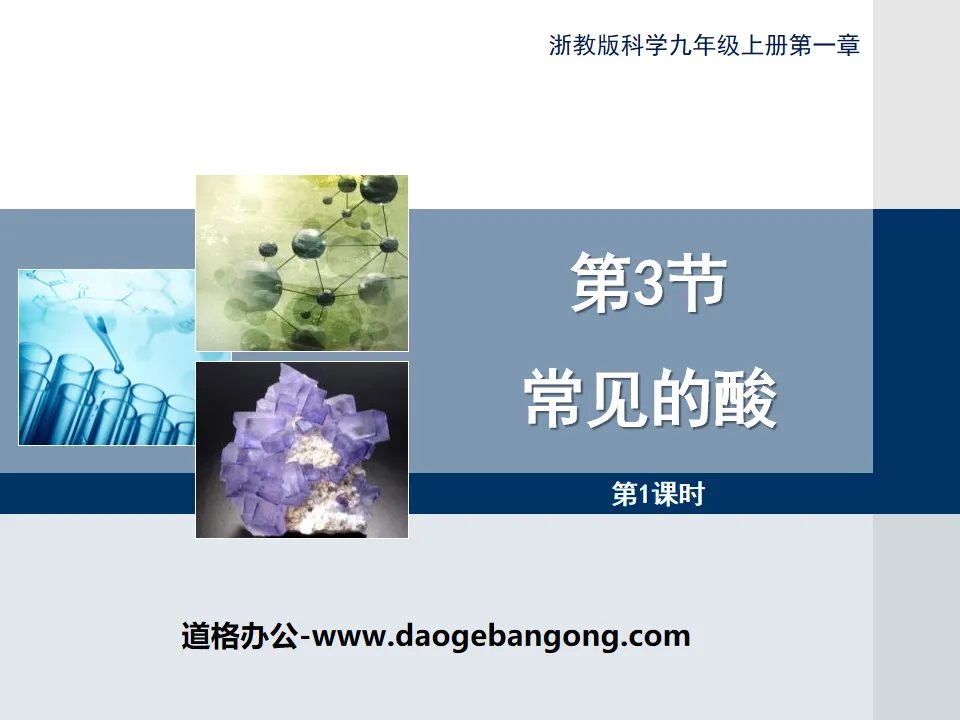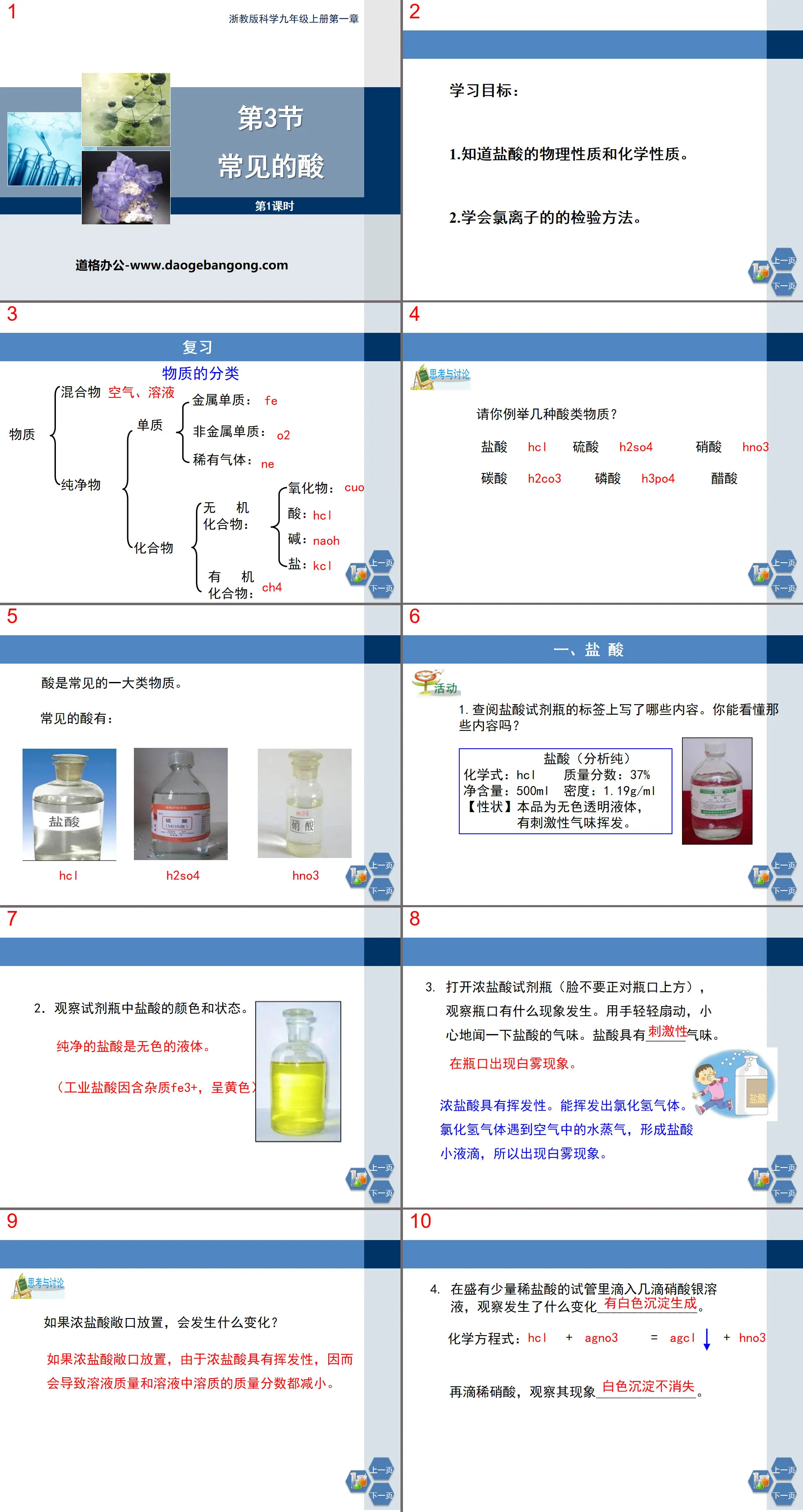Fifth Grade Science Volume 1, Textbook Edition
Science Edition for Sixth Grade Science Volume 2
Science Edition for Sixth Grade Science Volume 1
Third Grade Science Volume 2, Textbook Edition
Third Grade Science Volume 1, Textbook Edition
Fourth Grade Science Volume 2, Textbook Edition
Fourth Grade Science Volume 1, Textbook Edition
Fourth-grade science volume 2 of the E-education edition
Hunan Education Edition Fourth Grade Science Volume 1
Qingdao Edition Fourth Grade Science Volume 2
E-education edition fifth grade science volume 1
E-education edition fifth grade science volume 2
E-education edition sixth grade science volume 1
Fifth Grade Science Volume 2, Textbook Edition
Zhejiang Education Edition Seventh Grade Science Volume 2
Qingdao Edition Fourth Grade Science Volume 1

| Category | Format | Size |
|---|---|---|
| Zhejiang Education Edition Ninth Grade Science Volume 1 | pptx | 6 MB |
Description
"Common Acids" PPT (first lesson)
Part One Content: Learning Objectives:
1. Know the physical and chemical properties of hydrochloric acid.
2. Learn the testing methods for chloride ions.
Common acids PPT, part 2: hydrochloric acid
1. Check what is written on the label of the hydrochloric acid reagent bottle. Can you understand those contents?
2. Observe the color and state of the hydrochloric acid in the reagent bottle.
Pure hydrochloric acid is a colorless liquid.
(Industrial hydrochloric acid is yellow due to the impurity Fe3+)
3. Open the concentrated hydrochloric acid reagent bottle (do not point your face directly above the bottle mouth) and observe what happens at the bottle mouth. Gently fan it with your hands and smell the hydrochloric acid carefully. Hydrochloric acid has a ______ smell.
White mist appears at the mouth of the bottle.
Concentrated hydrochloric acid is volatile. Can emit hydrogen chloride gas. Hydrogen chloride gas encounters water vapor in the air and forms small droplets of hydrochloric acid, so white fog appears.
(1) Characteristics of hydrochloric acid (HCl)
1. Hydrochloric acid is an aqueous solution of hydrogen chloride (HCl) gas. Pure hydrochloric acid is a colorless, transparent liquid with a pungent and sour taste. The mass fraction of solute in commonly used concentrated hydrochloric acid is about 37%, and the density is 1.19 g/cm3.
2. Concentrated hydrochloric acid is volatile.
3. The reaction between hydrochloric acid and silver nitrate solution can produce a white precipitate of AgCl that is insoluble in dilute nitric acid.
(2) Chemical properties of dilute hydrochloric acid (HCl)
1. Take 2 test tubes and add a small amount of dilute hydrochloric acid solution to each. Then add a few drops of purple litmus test solution and colorless phenolphthalein test solution into two test tubes respectively, and observe and record the color.
2. Put the egg shell into the test tube containing hydrochloric acid, and insert the burning match into the mouth of the test tube, as shown in Figure 1-19. What did you see?
A large number of bubbles are produced, and the burning wood sticks are extinguished.
3. Take a rusty iron nail (the main component of rust is Fe2O3) and observe its color. Carefully slide the rusty iron nail along the wall of the test tube to the bottom of the test tube, drop a small amount of dilute hydrochloric acid into the test tube, and shake, as shown in Figure 1-20. After a while, take out the iron nails and rinse them with water. What happened to the surface of the iron nail and the color of the solution?
The rust gradually dissolves and the solution turns yellow
4. Add 2 ml of hydrochloric acid to a test tube containing a small amount of copper oxide powder and heat it slightly. What did you see?
The black powder gradually disappears and the solution turns blue
Common acid PPT, the third part: summary
Chemical properties of dilute hydrochloric acid (HCl)
1. Hydrochloric acid can react with indicator
It can make the purple litmus test solution turn red, but the colorless phenolphthalein test solution does not change color.
2. Hydrochloric acid can react with metals to produce salts and hydrogen
3. Hydrochloric acid can react with metal oxides to form salt and water
4. Hydrochloric acid can react with alkali to form salt and water
5. Hydrochloric acid can react with salt to form new salt and new acid
Common acid PPT, part 4 content: practice
1. Dilute hydrochloric acid solution can turn purple litmus test solution into red. This is because the solution contains a large amount of ( )
A. Hydrogen chloride molecule B. water molecule
C. Hydrogen ions D. Chloride
2. Which of the following four substances does not release gas after adding dilute hydrochloric acid? ( )
A. Iron nails B. Sodium carbonate
C. Marble D. Calcium hydroxide
3. To test whether a certain solution is acidic, take a small amount of the solution and conduct the experiment. The wrong approach is ( )
A. Add phenolphthalein test solution dropwise B. Add litmus test solution dropwise
C. Add sodium carbonate solution dropwise D. Add limestone
4. Hydrochloric acid is widely used in production and life. Which properties of hydrochloric acid are used in each of the following applications? Try to write a chemical equation for the reaction.
(1) Use hydrochloric acid to clean the rust on the steel surface before electroplating.
(2) Use dilute hydrochloric acid to remove scale on the inner surface of the boiler
[Main components are CaCO3 and Mg(OH)2]
(3) Stomach pain can be relieved by eating a few soda crackers [containing soda ash].
Keywords: Zhejiang Education Edition ninth grade science PPT courseware free download, common acid PPT download, .PPT format;
For more information about the "Common Acids" PPT courseware, please click on the Common Acids ppt tab.
"Common Acids" PPT courseware:
"Common Acids" PPT Courseware Part One: Acids Found in Life The word acid comes from sour wine. In the earliest times, when making wine, the more precious wines were sometimes stored in cellars. Under the action of microorganisms, acid was produced. You already know which acids...
"Common Acids" PPT (second lesson):
"Common Acids" PPT (Second Lesson) Part One Content: Learning Objectives: 1. Know the physical and chemical properties of sulfuric acid and nitric acid, and summarize the common characteristics of acids; 2. Learn the detection methods of sulfate ions. ... ... ... Common acids PPT, part two...
"Several Common Acids" Acids and Bases PPT Courseware 2:
"Several Common Acids" Acids and Bases PPT Courseware 2 Knowledge Review Knowledge Point 1 Properties of concentrated hydrochloric acid and concentrated sulfuric acid 1. Concentrated hydrochloric acid is volatile and can form _____ in the air, which is corrosive. 2. Concentrated sulfuric acid is easily soluble in water and has _____, ____ and corrosive properties..
File Info
Update Time: 2024-11-03
This template belongs to science courseware Zhejiang Education Edition Ninth Grade Science Volume 1 industry PPT template
"Common Acids" PPT (first lesson) Simple campus recruitment activity planning plan summary enterprise and institution recruitment publicity lecture PPT template is a general PPT template for business post competition provided by the manuscript PPT, simple campus recruitment activity planning plan summary enterprise and institution recruitment promotion Lecture PPT template, you can edit and modify the text and pictures in the source file by downloading the source file. If you want more exquisite business PPT templates, you can come to grid resource. Doug resource PPT, massive PPT template slide material download, we only make high-quality PPT templates!
Tips: If you open the template and feel that it is not suitable for all your needs, you can search for related content "Common Acids" PPT (first lesson) is enough.
How to use the Windows system template
Directly decompress the file and use it with office or wps
How to use the Mac system template
Directly decompress the file and use it Office or wps can be used
Related reading
For more detailed PPT-related tutorials and font tutorials, you can view: Click to see
How to create a high-quality technological sense PPT? 4 ways to share the bottom of the box
Notice
Do not download in WeChat, Zhihu, QQ, built-in browsers, please use mobile browsers to download! If you are a mobile phone user, please download it on your computer!
1. The manuscript PPT is only for study and reference, please delete it 24 hours after downloading.
2. If the resource involves your legitimate rights and interests, delete it immediately.
3. Contact information: service@daogebangong.com
"Common Acids" PPT (first lesson), due to usage restrictions, it is only for personal study and reference use. For commercial use, please go to the relevant official website for authorization.
(Personal non-commercial use refers to the use of this font to complete the display of personal works, including but not limited to the design of personal papers, resumes, etc.)
Preview










